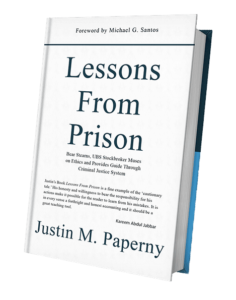Pleading guilty to health care fraud charges and being remanded to custody.
A good friend and client who plead guilty to health care fraud charges was remanded to custody following his sentencing last week. It was not unexpected.
“What percentage of your clients get remanded?” I have been asked.
About 1% of my clients get remanded at their sentencing. If 99% of my clients, and for that case most white collar defendants, are able to self surrender to prison why write this blog?
Easy…those in that small percentage need to prepare, to understand the complexities of getting remanded and how to properly prepare themself and their family.

Health Care Fraud Charges – Remanded To Custody
Before my client was sentenced he asked me if there were any benefits to getting remanded after sentencing.
There are a number of benefits. I will list 2:
- You get the clock started immediately on your sentence. Most of my clients have between 45-120 days to surrender to federal prison. Fortunately, because of our planning, the majority of them are also able to obtain the federal prison of their choosing. Still, if you go right in the clock starts ticking.
- Clients who have endured transit, shackles, con air and holding centers find the adjustment to federal prison camp life easier. They have something to compare it to. On my first day in federal prison, I wrote a letter to my then business partner, Sam Pompeo (call him if you need a real estate agent in Los Angeles!). It said, “Dude, this place is a real prison. This is not a country club.” Yes, I was in shock that first day and slightly off my game–I had just surrendered to prison after all. Still, had I served time in a county jail or holding facility the adjustment to federal prison camp would have been easier–I would have had that comparison.
Why have some clients been remanded to custody?
In the interest of time, I will not list every example, but just a few. Perhaps these examples will help you as you prepare for your own journey through the criminal justice system.
I was released on August 16, 2009. One day later, I obtained my first client, a doctor who had plead guilty to health care fraud charges. He read the 200 plus blogs I wrote from Taft Federal Prison Camp, then he called and hired me. I was so excited to have my first client. So excited in fact I had not given any thought on how much to charge him.
“How much do you charge?” he asked.
“I have no idea. I have been working 18 hours a day from federal prison, and doing it for free. Just send whatever you think seems fair,” I told him.
“How does $4,000 sound?” he asked me.
After earning 15 cents an hour in prison for the prior year, $4,000 might as well have been $400,000. Of course, I accepted, but I asked him to send $2,000, then presuming I followed through on my commitments (at that time one day out of prison I did not have a scope of work–just my word), I told him he could send the balance. Plus, I was worried how my probation officer would feel if I showed up to my first probation meeting with a $4,000 check from another convicted felon.
Back to my first client… Our work started well. I prepared him for his pre sentence investigation, and I worked with him to generate character reference letters. He also volunteered in a small community outside his home in Idaho.
He had a solid probation report. The probation officer recommended a sentence of 48 months, a slight departure from the guideline range of 51-61 months. He had an excellent public defender who was totally embracing of my help–I was delusional enough to believe every lawyer would be as welcoming: Sort of like winning on that first trip to Las Vegas–you expect to win every time!
We worked on this statement to the judge, decided he would ask for Sheridan Federal Prison Camp, and we confirmed his lawyer would ask for the Residential Drug Abuse Program.
We agreed he would call me after his sentencing, then begin our federal prison preparations. Naturally, I was concerned when I did not hear from him. One hour, became two, three, eight, nine and 10. After a few hours I knew he had been remanded and I had failed. As his prison consultant, I did not do my job. My first client in the business and I failed.
A day later a friend of his called to me that he had been sentenced to 36 months in federal prison. Thirty six months was incredible, given his guideline range and the pre sentence report.
“Why was he taken into custody?” I had no idea. I knew some judges had a policy of immediately remanding defendants–white collar–or not to custody. I had confirmed that this judge was not one of them.
“The judge was concerned for his safety. He knew he lived in a small town and many people in that small town were defrauded. He feared if he returned he could be at risk. To quell that risk, he had him remanded.”
I never considered it. Since then, I have never not considered it. Perhaps it was my Jewish guilt, but I sent him $2,000 dollars over 6 months to his commissary account. I figured I had only done half my job.
I had another client remanded to custody in February 2015. He called me after reading an article written about me in ThinkAdvisor. He was a former stockbroker, but ironically, like my first client, was about to be in trouble for health care fraud charges.
I helped find him a lawyer in San Diego. The lawyer called the U.S. Attorney, who had no idea about his case. He went in to proffer. Then he agreed to plead guilty and cooperate.
More than a dozen of my client’s victims showed up at his sentencing. They wanted blood. I was lecturing in New York at the time (his sentencing was moved again at the last minute; I had planned to be there but had already committed to speaking in New York). The victims read letters to the judge. They spoke of the fallout from his actions. It was all the way around a terrible experience. The judge, however, was moved by the defendant turning himself in.
My clients guideline range was around seven years in prison. The government asked for four years at his sentencing. The judge gave him 36 months. Pandemonium broke out. The victims, I later learned from my client’s two sons, went nuts. They spoke of a miscarriage of justice, of how the rich can buy their way out of jail. My client was stunned at the short sentence. To top if off the judge also granted RDAP. The only thing better would have been getting sentenced to 37 months instead of 36–that way he would have gotten a full year off for RDAP and not 9 months. Perhaps it was not a good idea to press his luck and ask the judge to change it to 37 months (which I have had some clients do.)
Following the outburst from the victims the judge had him remanded to custody. My client’s sons both felt the judge had to somehow make it up to the victims for the short prison sentence. One way to do that was having him taken out of the courtroom in handcuffs.
Back to my client I opened this blog about. Why was he remanded? Easy. Prior to sentencing we made plans with the court to have him remanded at his sentencing. He had been out long enough, he decided, and he wanted to get the show on the road (that is the first cliche I have used in awhile).
So what should you expect if you get remanded to custody?
To begin, if an immediate remand occurs, do not go into a state of shock. These things happen. The onus is on you, or your prison consulting team, to have every detail covered. I understand your desire to return home and decompress with family and prepare for your prison term. But that is no longer a reality.
Instead of returning home, you will wait in small cages while the Bureau of Prisons classifies you and designates you to your initial place of confinement. While sitting in that cage it is easy, I have been told, to feel traumatized. Although you may struggle emotionally with the immediate separation from family and community, it’s not all bad. In the end, you may appreciate that the time against the sentence begins to count immediately after sentencing. An immediate remand brings finality, a beginning to the end.
When the Marshals take you into custody, you become “an inmate.” You can prepare yourself to live “as an inmate” by steeling your mind to the reality that the design of the jail and prison system places an emphasis on security first. From the perspective of someone in custody—a prisoner—the emphasis on security will feel dehumanizing. Rather than recognizing you as a human being, those who work within the system will consider you as being a possible threat to security. To the extent that you condition yourself to anticipate obstacles and frustrations, you will strengthen your sense of direction and purpose. At White Collar Advice, we encourage our clients to repeat some version of the mantra:
“I am going to get through this phase of my life and return to society stronger than ever before.”
If a judge orders you into custody two US Marshals will step behind you. They will order you to place your hands behind your back, and then a Marshal will lock your wrists in handcuffs. Your family may be in shock, while victims will be celebrating. The two Marshals will lead you from the ornate courtroom into a verifiable dungeon-like environment. Instead of the beautiful, carved wood paneling and plush carpet of the courtroom, you will see bright fluorescent lights, drab paint, bars, concrete walls and floors. For the first time, you will also will feel the deafening noise that accompanies confinement.
The Marshals may have fingerprinted you before. But if you are in a facility for the first time (as was the case with my three clients who all plead guilty to health care fraud charges), you will enjoy that experience of inking your fingertips and rolling them across FBI documents once again. It is a process that any prisoner becomes used to over time, as authorities in every new facility will require fingerprints and mugshots.
After the fingerprinting and mug shot, Marshals will escort you to a judicial holding tank. To envision the holding tank, picture three concrete walls enclosed with a fourth wall of steel bars. A bench of some sort may or may not extend across the wall. Other people in custody will likely fill the holding tank, with many lying or sitting on the floor. You will wait in lockup with other prisoners who await transfer to a detention center. The day will pass. The next day, your first full day in prison, should be spent pursuing your goals and feeling gratitude for those that have stood by you–never forget, regardless of your suffering, it is harder on your family.
In future blogs, I will offer more insight into being processed into detention centers and prisons. For now, I hope all defendants reading this have a better understanding of why and how you could be taken into custody following your sentencing.
If you have questions email me at jp@whitecollaradvice.com, call 818-424-2220 or schedule a call here.
Best,
Justin Paperny




